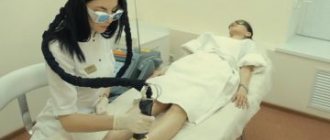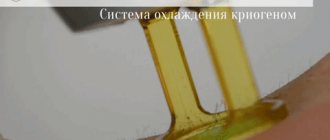Experts often have disputes about which technology is better and more efficient?
And in order to give a real assessment of which laser is better, you need to make a comparison and see how the laser behaves in operation.
In this article we will compare neodymium and diode lasers, because we often hear a similar question from our clients.
Let's compare:
- Operating principles of two lasers
- Which one is more effective?
- To summarize, which laser is better?
First, let's remember
Working principle of a diode laser
Diode laser or semiconductor lasers are the most common type of lasers in cosmetology, which are used to provide anti-inflammatory effects, for example, for hair removal or rejuvenation.
Semiconductor lasers are pumped by a strong forward current, and the Peltier element cools the laser tip to prevent overheating of the skin from such powerful light energy. By the way, the wavelength of light emitted by the diode handpiece is 808 nm.
Now let's remember
Contraindications for laser hair removal
After completing a course of laser therapy using a neodymium laser, you will be able to see for yourself that this is a very modern and effective method of solving the problem of unwanted vegetation.
However, not everything is so simple, and in any case we must not forget about possible contraindications. For example, it is worth delaying laser hair removal for women during pregnancy and lactation, people with infectious and skin diseases in the area where the procedure is to be performed, blood clotting disorders, signs of a fresh tan (the solarium and the beach should not be visited at least two weeks before the next session), as well as psychological diseases (especially epilepsy).
It is also undesirable to perform laser hair removal if the skin is damaged or the presence of malignant neoplasms is suspected. In all these cases, instead of a positive effect, you will simply aggravate the existing problem, which, of course, is very undesirable.
Operating principle of neodymium laser
Neodymium laser is called short pulse or Q-switch for a reason. The fact is that inside the handpiece there is a Q-switch, a mechanism that creates ultra-short time light pulses that can break down artificial pigment, natural pigment and carry out carbon peeling.
ND:YAG is the most common type of solid-state laser based on yttrium aluminum garnet activated by neodymium ions. Its difference from other lasers is its long wavelength - 1064 nm.
This wavelength can penetrate several millimeters into tissue and be absorbed by a certain chromophore, which is located deeply.
Prices
Neodymium laser for hair removal gives good long-term results, but this procedure is not cheap. At the initial appointment, the specialist will conduct an examination, give recommendations, and, depending on the area of hair removal, name the cost of the course.
Hair removal in the chin area will cost an average of about 2,500 rubles, in the upper lip area - from 1,500 to 3,000 rubles, along the bikini line - on average 7,000 rubles, buttocks - 8,000 rubles, hips - 12,000 rubles.
You can buy the device itself in the online store. The price for it will depend on the manufacturer and its main characteristics. For example, Magic ONE can be purchased for 1,500,000 rubles.
What is the fundamental difference between the two lasers?
Both lasers, the diode and neodymium lasers, shine in the near-infrared spectrum of radiation, which is a non-ionizing type of exposure, that is, a safe type of exposure for the cells of the human body.
The fundamental difference is several factors:
- Wavelength
- Chromophore
- Light impulse unit
- Functional
The wavelength of the diode laser is 808 nm; the chromophore for absorption will be the melanin of the hair. A chromophore is a target in the skin or body that absorbs a specific wavelength of light and is typically destroyed by light energy.
The unit of measurement for a diode laser's light pulse is milliseconds, a flash long enough to maximize absorption by the hair and heat the hair follicle. Therefore, a diode laser is used for hair removal.
The wavelength of the neodymium laser is 1064 nm, the chromophore will be predominantly an artificial pigment. And the unit of measurement for a light pulse is the nanosecond, which is an exceptionally fast flash of light to safely absorb light energy from the tattoo and destroy the pigment into particles. Therefore, nanosecond neodymium is used to remove tattoos and permanent makeup.
Operating principle
The device is a modern laser installation of a new generation. The impact is carried out through a short pulse (the flash duration is only 5 nanoseconds).
When it comes to tattoo removal, several types of attachments are used - each group of pigments has its own beam color. Under the influence of the beam, the pigment located in the deep layers of the dermis is broken into small particles, and then the body removes it naturally - no spots, no other marks, or scars remain.
Carbon peeling is also called laser facial cleansing, since as a result of the effect, pores narrow, “black spots” disappear, and the quality and color of the skin improves. During the procedure, dead epidermal cells are dissolved, resulting in a pronounced rejuvenating effect. Renewed skin becomes more receptive to the action of all kinds of care products - masks, creams, skin density increases, microcirculation improves, tissues are better supplied with oxygen. According to the results obtained, carbon peeling is comparable to traditional acid peels of light and medium action, but it has important advantages - painlessness, minimal discomfort during the procedure, and no recovery period.
If the main problem is the presence of age spots, freckles, the laser will again come to the rescue. Gently and effectively removes both epidermal and dermal pigment.
Which one is more convenient for a cosmetologist to work with?
A specialist, choosing the direction in which he wants to develop, determines the services that he will provide to his clients. If it is tattoo removal or carbon peeling, then it is worth considering the neodymium Q-switch laser, as it meets these needs.
And if you are engaged in epilation, then the absolute right choice will be a diode laser, since this is, perhaps, the only laser among epilators that works on the principle of selective photothermolysis, where there is a simple truth: light absorption should pass through only one chromophore in order to eliminate the occurrence of side effects and improve results.
Recovery
Recovery after laser does not require long-term rehabilitation in special conditions. There is no skin irritation - only moderate redness, which disappears quickly. Therefore, maintenance procedures are not particularly required - skin and hair regeneration is very high, but to maintain ideal skin condition, it is enough to undergo a session once a year.
Our clinic is ready to provide all kinds of discounts to regular customers, services of qualified specialists and professional equipment. We care about our patients and their health. Our prices are quite reasonable and acceptable, and we are always happy to see you in the branches of our clinic.
Epidermal protection
During any laser hair removal, laser radiation first encounters the epidermis, which always contains a lot of melanin: it is present even in light skin of people with phototype I. This circumstance requires the use of various methods of removing heat from the surface of the skin, in other words, cooling it.
There are three common ways to cool the skin: using cryogas, a stream of cold air and contact. A combination of these methods is also used. In the first case, an inert non-flammable substance, for example tetrafluoroethane, is supplied to the skin in the direction of the laser pulse, which quickly evaporates and cools its surface as it evaporates. Cooling using cryogas is also called dynamic cooling. In the second case, the skin is blown with a continuous flow of cold air. For this, as a rule, additional equipment is used - cold air generators, for example Cryo devices (Zimmer MedizineSysteme, Germany). The third method is to use sapphire light guides, which are in contact with the skin and are forcibly cooled using Peltier elements.
All three methods allow you to effectively cool the skin, however, the contact method may be more preferable, since when using it, the cooling efficiency is less dependent on the technique of the procedure: the glass of the light guide is always in contact with the skin during the pulse. The contact cooling method is typical for diode lasers, as well as IPL systems.
An ideal laser for hair removal should have high fluence, the ability to generate both long and short pulses, operate in sub-pulse mode, be equipped with light guides with different spot sizes for different tasks, including a large spot size for quickly treating large areas, and a reliable system removal of heat from the surface of the skin.
Fluency and spot size
Fluence (energy flux density) is the most important parameter on which the effectiveness of laser hair removal depends. This parameter means how much laser energy is transmitted per unit of skin surface during the procedure. The larger it is, the more energy will be delivered to the hair follicle. The fluence is directly related to the energy and power of the laser device, but is not an analogue of these parameters, but depends on the area of the spot size. With a radiation energy of 100 joules (J), the distribution of this energy over a spot measuring 1x1 cm will give a fluence of 100 J/cm2. The same energy of 100 J distributed over a spot measuring 2x2 cm will give a fluence of 25 J/cm2.
When choosing a laser device, you should be interested not in its energy, but in its fluence, as well as the range in which this fluence can be changed. An hair removal laser with a low maximum fluence may be ineffective in some cases, for example for removing coarse (large diameter) hair.
The size of the spot is also an important parameter. Firstly, as the spot size increases, the proportion of scattered light decreases and, as a result, the penetration depth increases, and hence the efficiency in epilating deep-lying hair. Secondly, the large spot size allows large areas to be treated at high speed. For example, with a spot size of 2.2x3.5 cm, epilation of a man's back will take about 10 minutes, and with a spot size of 1x1 cm - more than an hour. However, despite the fact that the small size of the spot requires the use of a larger fluence, it cannot be completely abandoned, since it is needed for hair removal in hard-to-reach areas, for example, above the upper lip.
Influence of spot size on the penetration depth of laser radiation. As radiation penetrates the skin, it is scattered, so as the size of the spot increases, the depth at which the effective fluence value will be achieved will increase.
Pulse duration and series of sub-pulses
It takes some time for the heat to spread from the heated hair shaft to the stem cells of the follicle. This means that short-pulse lasers are not suitable for laser hair removal; or rather, the use of such lasers will burn out the hair shaft, but may leave the follicle stem cells undestroyed. Typically, laser hair removal uses pulses lasting from 10 to 100 milliseconds or more. Moreover, short pulses are suitable for thin hair, and long pulses are suitable for thick, coarse hair.
A good property of a laser for hair removal is the ability to emit a series of sub-pulses with short intervals between them. This method allows you to gradually warm up the hair shaft without the risk of damaging the epidermis: in the intervals between pulses, the epidermis has time to cool down, but the hair does not.











